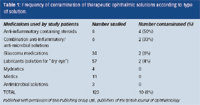Contamination of ophthalmic solutions: should we be worried?
The use of ophthalmic solutions tends to increase with age; however, as use of these solutions, both therapeutic and diagnostic, rises, so too does a patient's risk of infections.

Key Points
The use of ophthalmic solutions tends to increase with age; however, as use of these solutions, both therapeutic and diagnostic, rises, so too does a patient's risk of infections. Recent events, such as the Fusarium keratitis outbreak that led to the recall of Bausch & Lomb's ReNu with MoistureLoc contact lens storage solution, have naturally caused ophthalmologists to question the safety of ophthalmic solutions. In fact, bacterial contamination of ophthalmic solutions has been reported in many studies conducted over the course of more than two decades.
The problem of solution storage is particularly acute in long-term care facilities where a large number of solutions may be stored for an equally large number of patients. Because eye diseases are common in patients in long-term care facilities and ophthalmic solutions are frequently prescribed, a team led by Dr Danny Hirsch-Kauffman Jokl assessed the frequency of bacterial contamination of ophthalmic solutions used in a long-term care facility and the characteristics associated with them.
Dirty or clean?
In order to identify any bacteria present in the solutions, Dr Jokl and his team cultured each solution by placing five drops into 5 ml of enriched thioglycolate medium. The number of days since the bottle was first opened was noted and the visual appearance of the bottle was recorded as either "clean" or "dirty." "Dirty" bottles were those that had missing caps, worn labels or dried medications or dirt present on the cap or surface of the bottle. Unopened bottles were not cultured.
Steroids more prone to contamination
A total of 123 solutions, in use by 47 patients, were cultured. The solutions tested were anti-inflammatory containing steroids (eight), combination anti-inflammatory/anti-microbial solutions (six), glaucoma medications (34), dry eye lubricants (57), mydriatics (four), miotics (11) and anti-microbial solutions (three).

Interestingly, it was discovered that steroid-containing solutions were 5.8 times more likely to be contaminated than non-steroidal solutions and that all of the anti-inflammatory steroid-containing solutions cultured had identical compositions.
This is not the only study to have found a link between steroid-containing solutions and contamination; for example, an earlier study1 discovered that beta blockers, steroid-containing drops and ocular lubricants were the solutions most likely to be contaminated. If this correlation between steroidal solutions and contamination continues to be seen in similar studies, much more attention will need to paid to the problem by ophthalmologists and manufacturers alike.
A disproportionate contamination rate of corticosteroid-containing solutions was also found, suggesting that there may be a common source of contamination during the manufacturing process. However, this study was not able to illuminate this issue further since no unopened bottles were cultured.
Dr Jokl and his team also found that, of the six combination anti-microbial/anti-inflammatory steroid-containing medications, the two that were found to be contaminated contained sulfacetamide sodium as the antibiotic component, whereas the four sterile solutions contained polymyxin B and neomycin.
Why patients with inflammatory bowel disease might need to see their ophthalmologist
January 4th 2023Ocular involvement in IBD is a rare extraintestinal manifestation, but may be critical because of its potential sight-threatening complications if not treated promptly and accurately, according to researchers.
The pathophysiology and pathomorphology of corneal ectasia: Part 4
November 14th 2022Corneal cross-linking (CXL) is improving all the time, although all protocols retain the basic requirements for oxygen, riboflavin and UV light. Recent developments mean that CXL at the slit lamp is feasible, which will improve access to the procedure.
